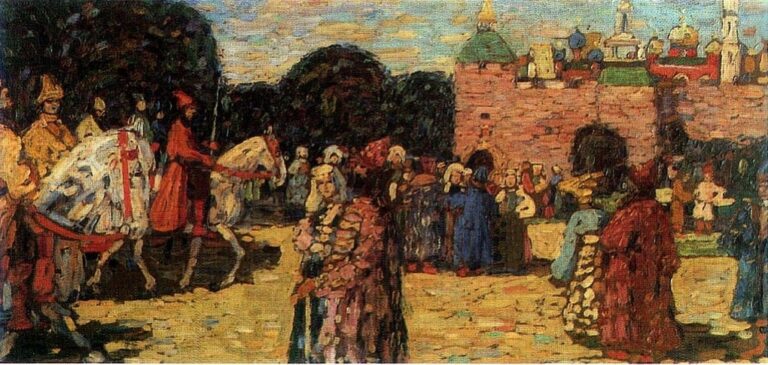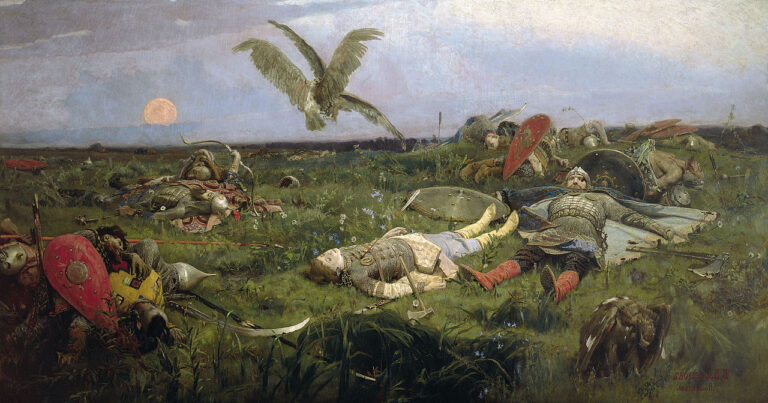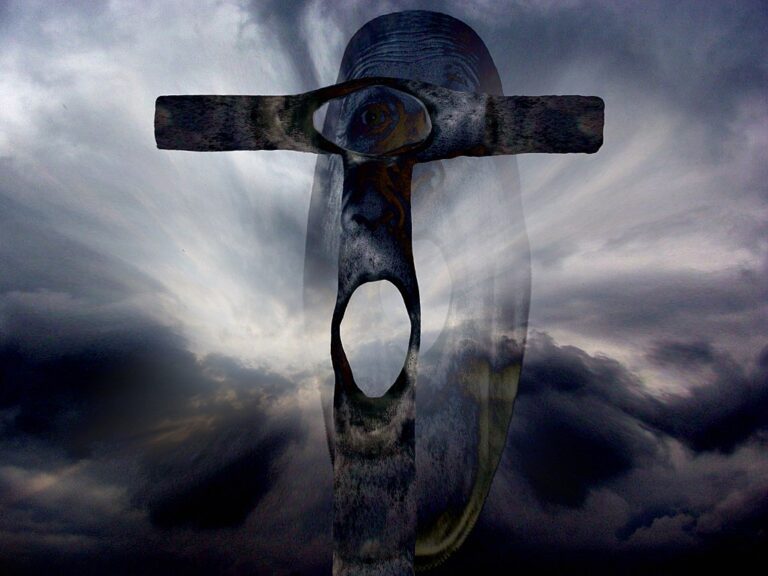Max Ernst: Pioneering Surrealist Painter of the 20th Century
Born: 2 April 1891, Brühl, German Empire
Death: 1 April 1976, Paris, France
Art Movement: Dada, Surrealism
Nationality: German-American-French
Influenced By: Pablo Picasso, Vincent van Gogh, and Paul Gauguin
Max Ernst: Pioneering Surrealist Painter of the 20th Century
Life and Career of Max Ernst
Max Ernst’s artistic journey spans multiple movements and continents, making him one of the most influential figures in modern art. His innovative techniques and distinctive visual language evolved through significant historical events and artistic relationships.
Early Years and Education
Born on April 2, 1891, in Brühl, Germany, Max Ernst grew up in a middle-class family. His father, a teacher and amateur painter, inadvertently influenced young Ernst’s perception of art.
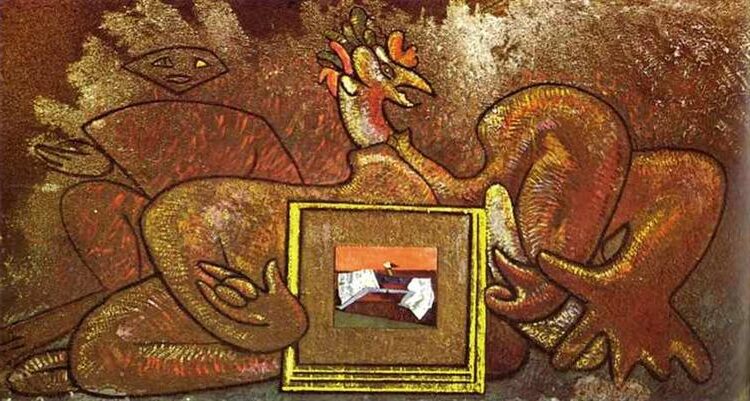
Loplop Introduces Loplop (1930) by Max Ernst
Ernst studied philosophy and psychology at the University of Bonn from 1909 to 1914. This academic background would later inform his artistic exploration of the unconscious mind.
Unlike many of his contemporaries, Ernst had no formal artistic training. He was largely self-taught, developing his skills through experimentation and observation.
His early artistic development was interrupted when he was drafted to serve in World War I, an experience that profoundly impacted his worldview and later artistic expressions.
Influence and Role in Dada Movement
After World War I, Ernst became a founding member of the Cologne Dada group in 1919. The nihilistic Dada movement emerged as a reaction to the horrors of war and rejected conventional aesthetics.
Ernst pioneered collage techniques during this period, cutting and reassembling images from catalogs and scientific journals to create unsettling juxtapositions. These works challenged rational thought and artistic traditions.
He organized provocative Dada exhibitions in Cologne that shocked audiences and established his reputation as an artistic rebel. His collaboration with fellow Dadaists, including Johannes Baargeld, produced innovative publications and artworks.
Ernst’s association with the Das Junge Rheinland group further expanded his connections within the German avant-garde scene. During this time, he was married to art historian Luise Straus.
Transition to Surrealism
Ernst moved to Paris in 1922, where he connected with Surrealist poets and artists. He quickly became a central figure in the Surrealist movement led by André Breton.
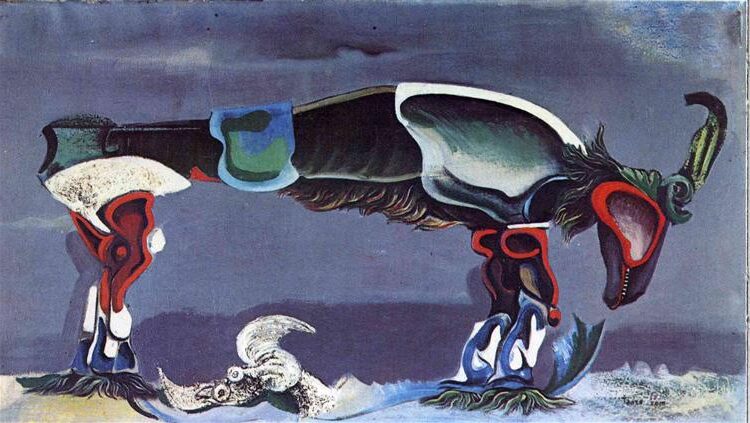
The Beautiful Season (1925) by Max Ernst
During the 1920s, Ernst developed the frottage technique. He also created the grattage technique later on. These methods embraced chance and the unconscious—core principles of Surrealism.
His mysterious, dreamlike paintings featured bird-men, forests, and strange landscapes that explored psychological themes. Works like “The Elephant Celebes” (1921) and “Europe After the Rain” (1940-42) became iconic Surrealist masterpieces.
Ernst’s relationship with poet Paul Éluard and his wife Gala formed a complex personal and artistic triangle that influenced his work during this period.
World War II and Later Life
When World War II began, Ernst was detained as an enemy alien in France. With the help of patron Peggy Guggenheim (whom he briefly married), he escaped to the United States in 1941.
In America, Ernst found new inspiration in the desert landscapes of Sedona, Arizona, where he lived with fellow Surrealist painter Dorothea Tanning, whom he married in 1946.
Ernst became a naturalized American citizen in 1948 but returned to France in 1953, where he also gained French citizenship. His later work continued to evolve, incorporating elements of abstraction while maintaining his distinctive visual vocabulary.
He received growing recognition in his final decades, including the Grand Prize for painting at the 1954 Venice Biennale. Ernst died in Paris on April 1, 1976, just before his 85th birthday, leaving behind an extraordinary artistic legacy.
Artistic Techniques and Legacy
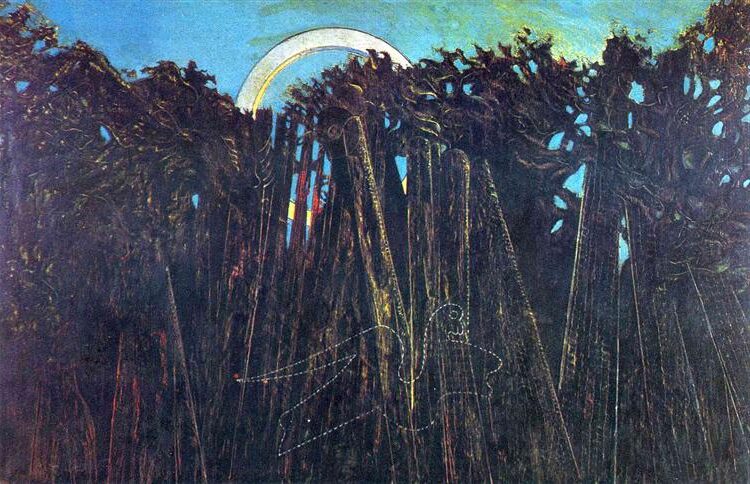
The Embalmed Forest (1933) by Max Ernst
Max Ernst’s artistic legacy is built on his groundbreaking techniques and innovative approaches to creating art. He developed several methods that would change how artists approached their work, blurring the line between conscious creation and unconscious expression.
Development of Frottage and Grattage
Frottage, meaning “rubbing” in French, was one of Ernst’s most significant contributions to modern art. He discovered this technique in 1925 while making pencil rubbings of various textured surfaces like wood grain, leaves, and fabric. By placing paper over these textures and rubbing with graphite, Ernst created surprising organic forms that emerged seemingly by chance.
Grattage extended this concept to painting. Ernst would place canvas over textured objects, then scrape paint across the surface. This created unexpected patterns and textures that sparked his imagination and led to dreamlike landscapes and creatures.
These techniques allowed Ernst to tap into what Surrealists called “automatism.” Unlike traditional painting methods that relied on planning and precision, Ernst’s approach embraced randomness and spontaneity.
Exploration of the Unconscious
Ernst’s work deeply connected with Freudian dream theory and psychiatry. He used his art to explore the hidden regions of the mind, creating images that resembled dream states rather than waking reality.

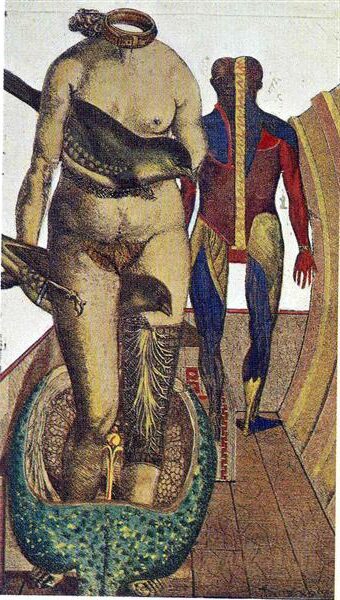
His famous painting “The Elephant Celebes” (1921) combines mechanical and organic forms in a way that defies logical interpretation. These dreamlike imagery compositions invited viewers to confront their own unconscious fears and desires.
Ernst believed artistic creation could bypass rational thought. He wrote: “The artist’s role differs from the poet’s in that he must directly touch the unconscious.”
His work influenced Abstract Expressionism by demonstrating how art could emerge from psychological processes rather than careful planning. Ernst showed that creativity often springs from allowing the mind to wander into unexplored psychological territory.
Collage and Overpainting
Ernst revolutionized collage techniques in ways that went beyond what Pablo Picasso and other contemporaries were doing. He combined unrelated images from Victorian catalogs, scientific journals, and pulp novels to create unsettling new realities.
His overpainting technique involved adding paint to existing printed materials. Ernst would transform mundane illustrations into mysterious landscapes or bizarre creatures. This approach created visual puzzles that challenged viewers’ perceptions.
Ernst’s collages differed from earlier experiments by focusing on seamless integration rather than obvious juxtaposition. He meticulously blended elements together, creating dreamscapes that seemed both impossible and eerily familiar.
This technique influenced generations of artists working in mixed media. Ernst demonstrated that art need not be created entirely from scratch—it could transform and recontextualize existing materials into something entirely new and thought-provoking.
Significant Works and Collaborations
Max Ernst created a remarkable body of work spanning paintings, sculptures, literature, and collaborative projects. His innovative techniques and partnerships helped define Surrealism and Dadaism in the 20th century.
Iconic Paintings and Sculptures
“The Elephant Celebes” (1921) stands as one of Ernst’s most recognizable works, featuring a mechanical elephant-like figure in a dreamlike landscape. This painting exemplifies his early Surrealist style, combining bizarre imagery with precise technique.
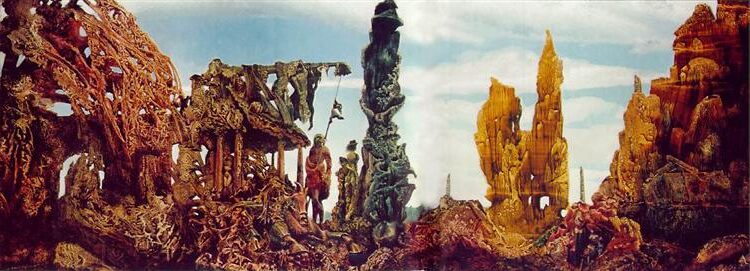
Europe after the Rain II (c. 1941) by Max Ernst
“Europe After the Rain II” (1940-42) depicts a haunting post-apocalyptic landscape created during his exile from Nazi Germany. Ernst developed his famous “decalcomania” technique for this work, creating textured surfaces by pressing paint between surfaces.
“Two Children Are Threatened by a Nightingale” (1924) combines painting with wooden elements, representing an early mixed-media approach. The small wooden gate actually opens, adding an interactive dimension uncommon in paintings of that era.
“The Virgin Chastises the Infant Jesus” (1926) shocked viewers with its irreverent religious imagery, demonstrating Ernst’s willingness to challenge conventions and taboos.
“Forest and Dove” (1927) showcases his fascination with dense, mysterious forest imagery, a recurring theme throughout his career.
Literary Works and Publications
Ernst didn’t limit himself to visual art. His literary collaborations produced significant works like “Une Semaine de Bonté” (A Week of Kindness), a “collage novel” from 1934 that combined Victorian illustrations into disturbing surreal narratives.
“Histoire Naturelle” (1926) featured rubbings made from various textured objects, a technique Ernst called “frottage.” These works blur the line between visual art and literary expression.
“Les Malheurs des Immortels” (The Misfortunes of the Immortals), created with poet Paul Éluard in 1922, combined Ernst’s visual elements with Surrealist text. This collaboration exemplified the Surrealist interest in mixing artistic mediums.
Ernst also contributed to “Littérature,” the influential journal of the early Surrealist movement. His written work often explored dream imagery and unconscious symbolism, consistent with his visual art themes.
Partnerships in Art and Life
Ernst’s artistic life was enriched by significant collaborations and relationships. With Jean (Hans) Arp, he founded the Cologne Dada group in 1919, challenging artistic conventions after World War I.
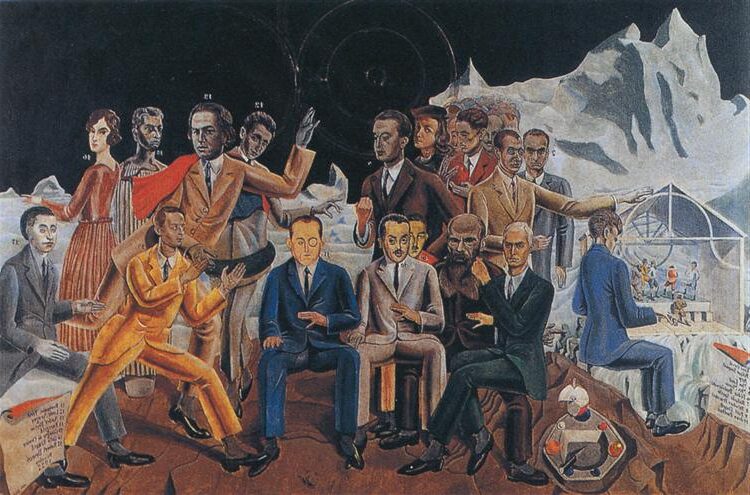
A Friends’ Reunion (1922) by Max Ernst
His association with André Breton, Surrealism’s founder, led to Ernst becoming a central figure in the movement. Breton championed Ernst’s work in Paris, helping establish his international reputation.
Ernst’s personal relationships often intertwined with his artistic ones. His marriage to Marie-Berthe Aurenche coincided with some of his most significant surrealist works, though the relationship later deteriorated.
His son, Jimmy Ernst, followed in his father’s footsteps to become a notable painter. During World War II, Max was imprisoned at Camp des Milles in France. After his escape, he moved to America where he collaborated with Dorothea Tanning, another prominent Surrealist artist.
Frequently Asked Questions
Max Ernst revolutionized modern art through innovative techniques and dreamlike imagery. His work spanned several influential movements and continues to inspire artists today.
What are the defining characteristics of Max Ernst’s artistic style?
Max Ernst’s artistic style features dreamlike, fantastical imagery that blurs the line between reality and imagination. He often incorporated bizarre juxtapositions of objects and creatures in unexpected settings.
His work frequently displays intricate textures and patterns, achieved through techniques like frottage, grattage, and decalcomania. These methods created unique surfaces that enhanced the mysterious quality of his paintings.
Ernst’s color palette typically included earthy tones, vibrant contrasts, and sometimes muted backgrounds that emphasized his strange biomorphic forms and forest-like landscapes.
Which art movement is Max Ernst commonly associated with?
Max Ernst is most strongly associated with Surrealism, where he became one of the movement’s founding members. His exploration of the unconscious mind and dream imagery perfectly aligned with Surrealist principles.
Before Surrealism, Ernst was a significant figure in the Dada movement, embracing its anti-war stance and rejection of conventional aesthetics after World War I.
He later developed connections with Abstract Expressionism in the United States, showing his adaptability across multiple influential 20th-century art movements.
What was the impact of Max Ernst’s artwork on 20th-century painting?
Ernst’s experimental techniques fundamentally changed how artists approached the creative process. His methods of frottage and grattage influenced generations of painters seeking new ways to create texture and imagery.
His exploration of the unconscious and dream imagery helped establish Surrealism as a major force in modern art. This psychological approach to painting opened new possibilities for artistic expression.
Many contemporary artists continue to draw inspiration from Ernst’s collage techniques and his ability to create mysterious, narrative-rich visual worlds.
Can you list some of Max Ernst’s most influential works?
“The Elephant Celebes” (1921) stands as one of Ernst’s early masterpieces, featuring a mechanical elephant-like figure in a surreal landscape.
“Europe After the Rain II” (1940-42) depicts a haunting, post-apocalyptic landscape created using his decalcomania technique.
“The Robing of the Bride” (1940) showcases Ernst’s ability to create mysterious figures and rich symbolism.
“Two Children Are Threatened by a Nightingale” (1924) combines painting with unusual sculptural elements, demonstrating his innovative mixed-media approach.
How did Max Ernst’s early life and experiences influence his art?
Ernst’s service in World War I profoundly affected his artwork, leading to anti-war themes and distrust of authority that permeated his Dada period. The trauma of war pushed him toward creating disturbing, fragmented imagery.
His childhood fascination with birds influenced his artwork throughout his career. Ernst developed an alter ego called “Loplop, the Bird Superior,” which appeared in many works.
Growing up with a father who painted as a hobby exposed Ernst to art early, while his studies in philosophy and psychology at the University of Bonn informed his intellectual approach to creating meaningful symbols.
What techniques did Max Ernst develop or popularize in his painting career?
Frottage became one of Ernst’s signature techniques. In this technique, he placed paper over textured surfaces and rubbed with a pencil or crayon to create unexpected patterns. He then transferred this technique to canvas as “grattage.”
Decalcomania was another method Ernst mastered. He pressed paint between surfaces, then pulled them apart to create intricate, organic formations. These formations resembled forests, landscapes, and mysterious creatures.
Ernst also pioneered innovative collage techniques. In these techniques, he cut and combined images from catalogs and scientific journals. This created surreal juxtapositions that challenged conventional reality and sparked the imagination.




